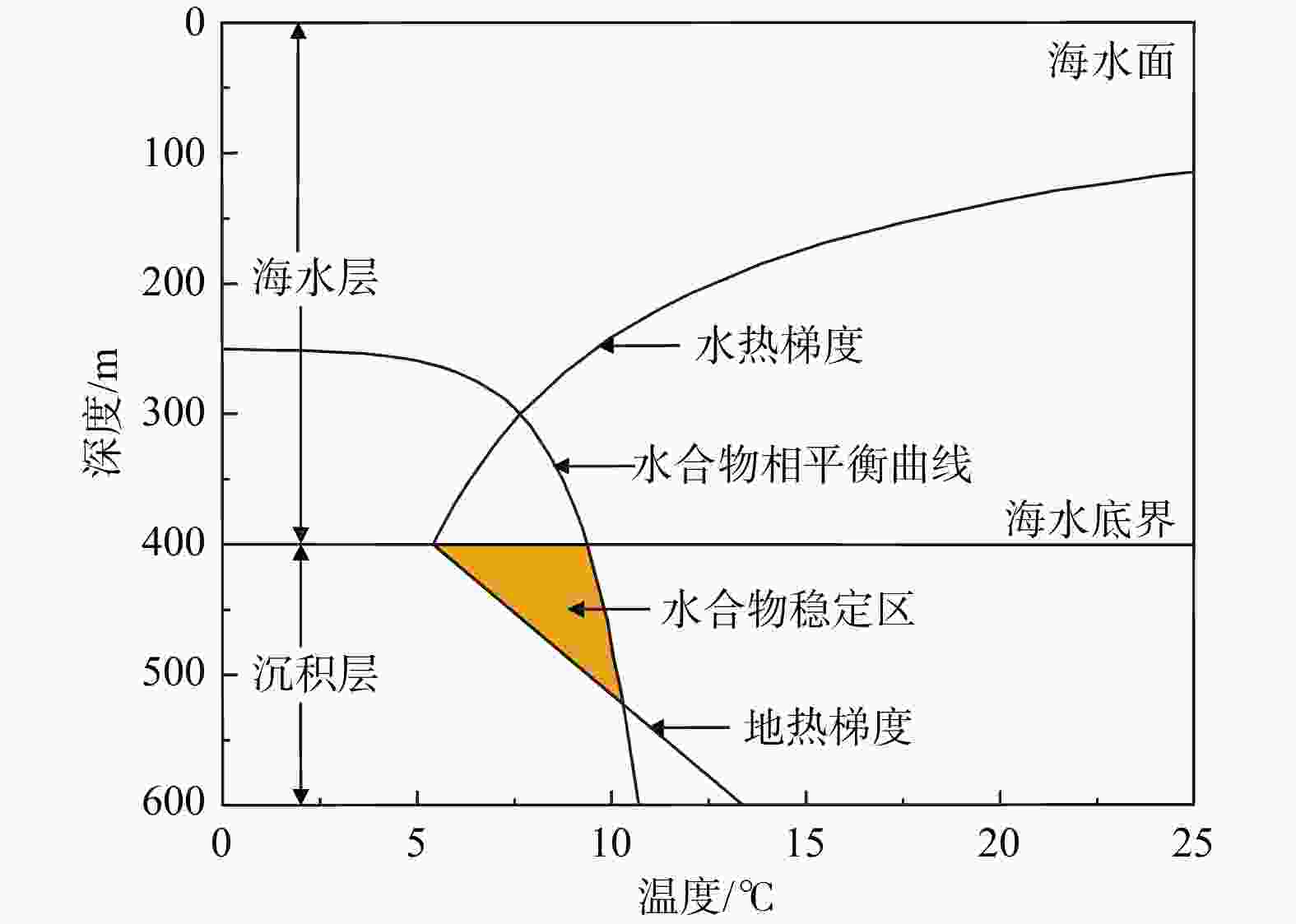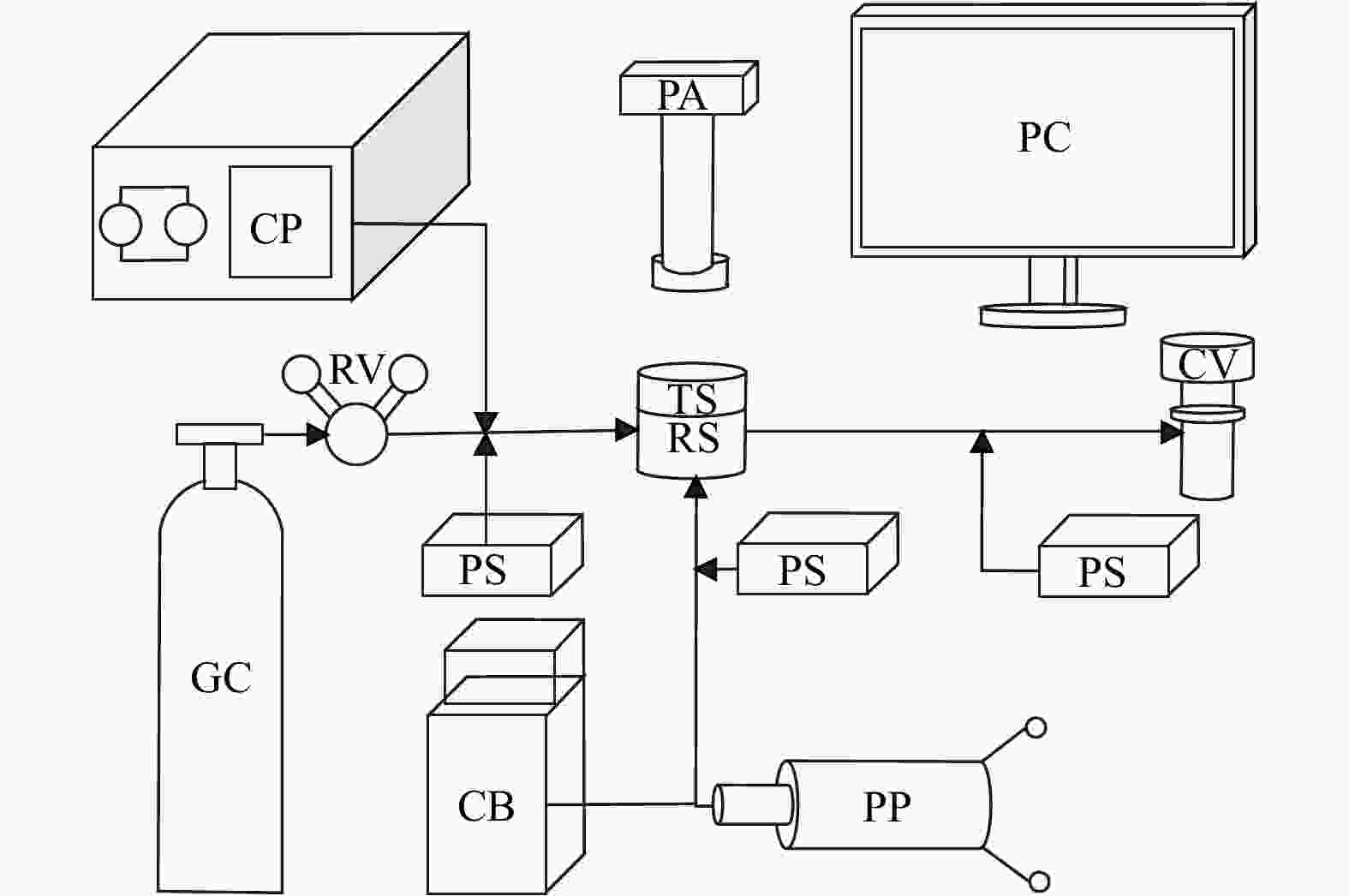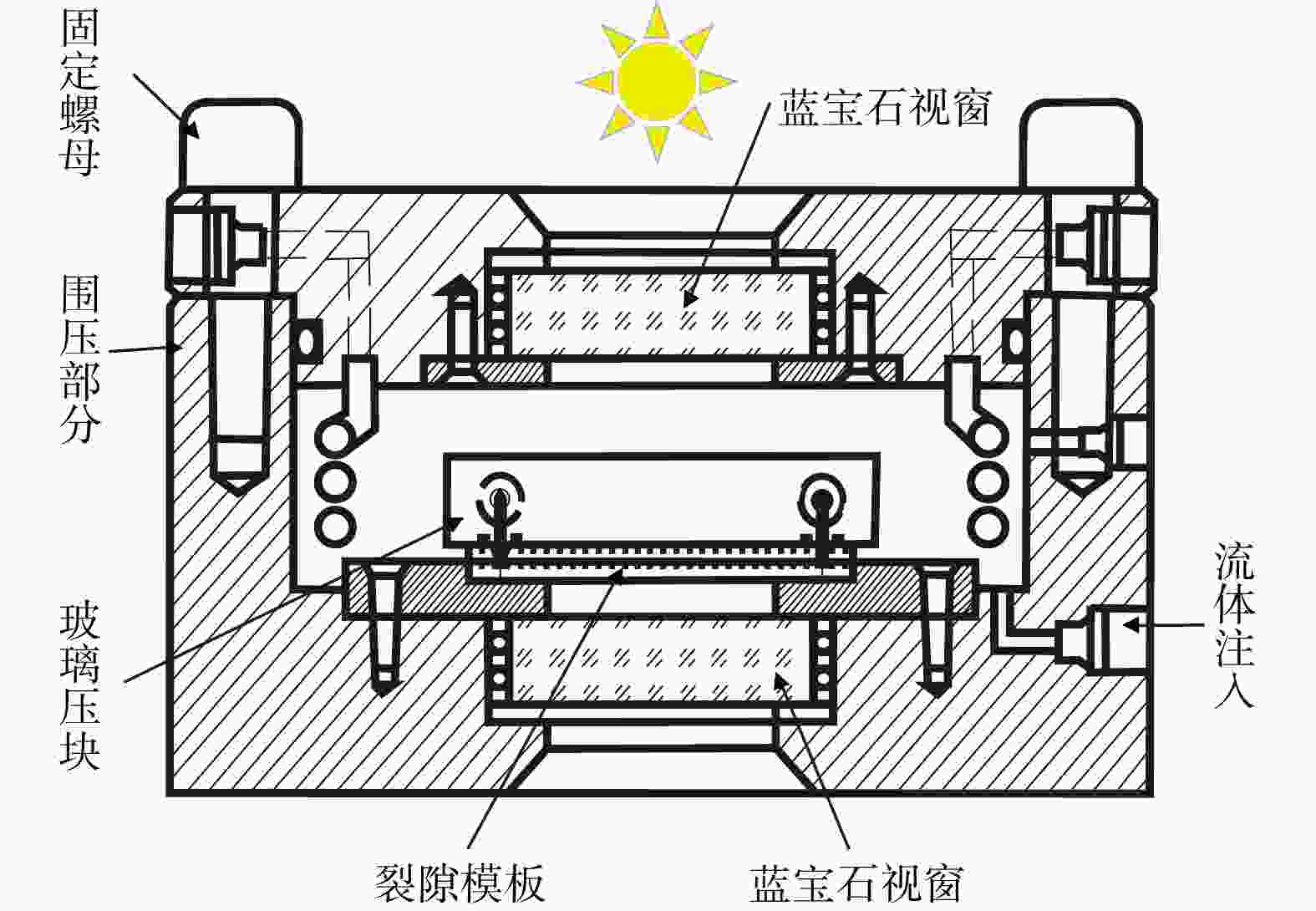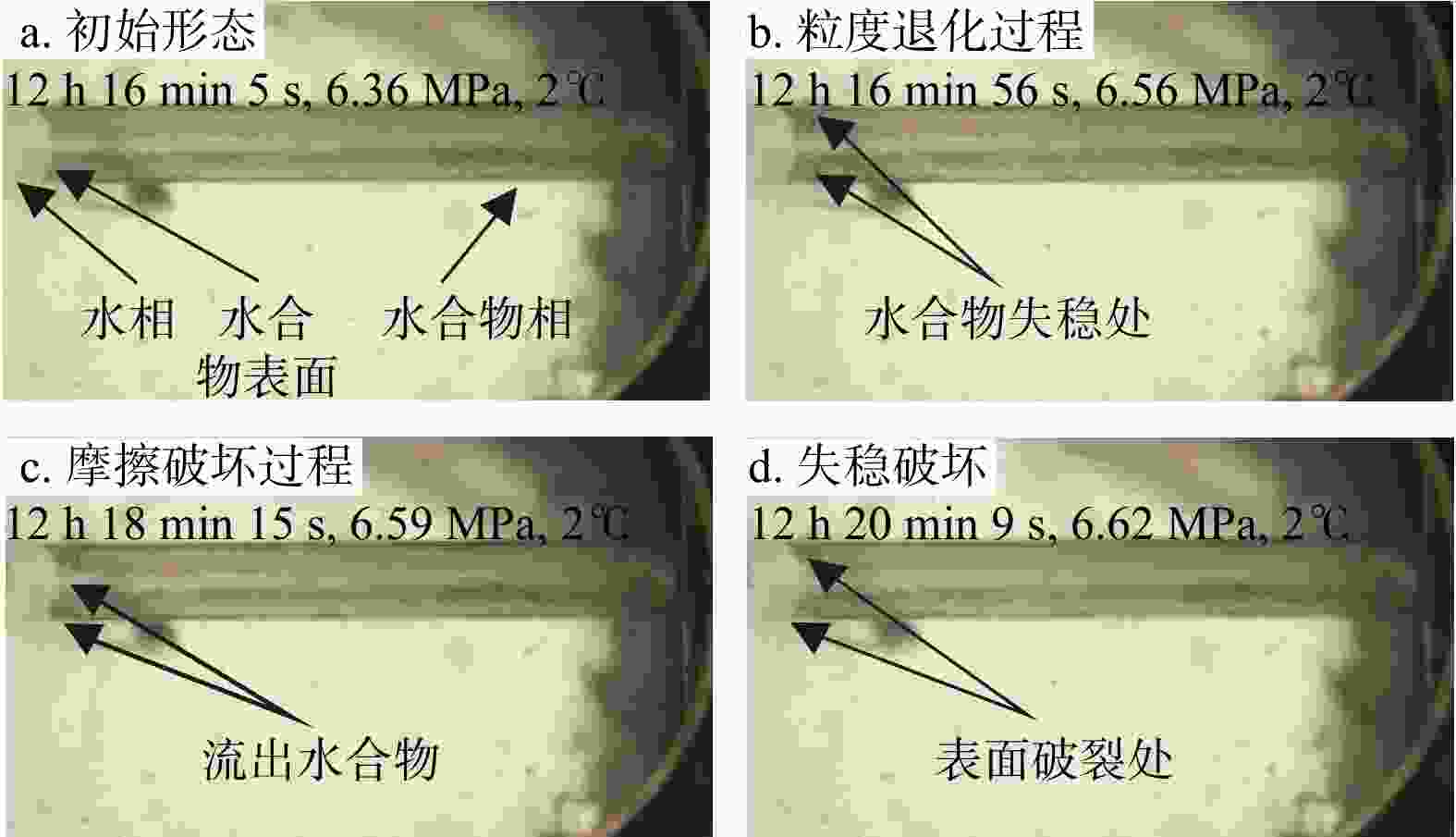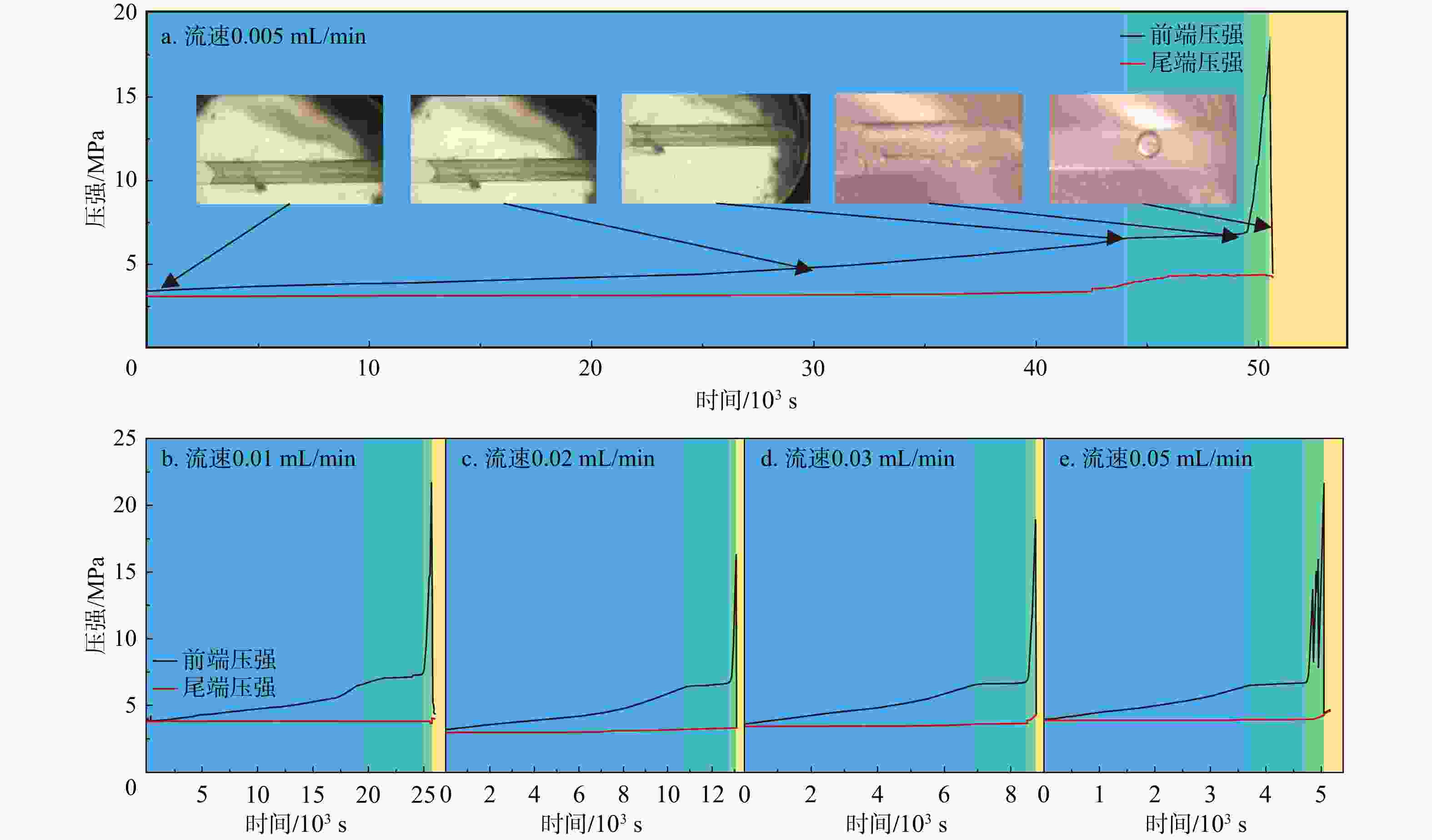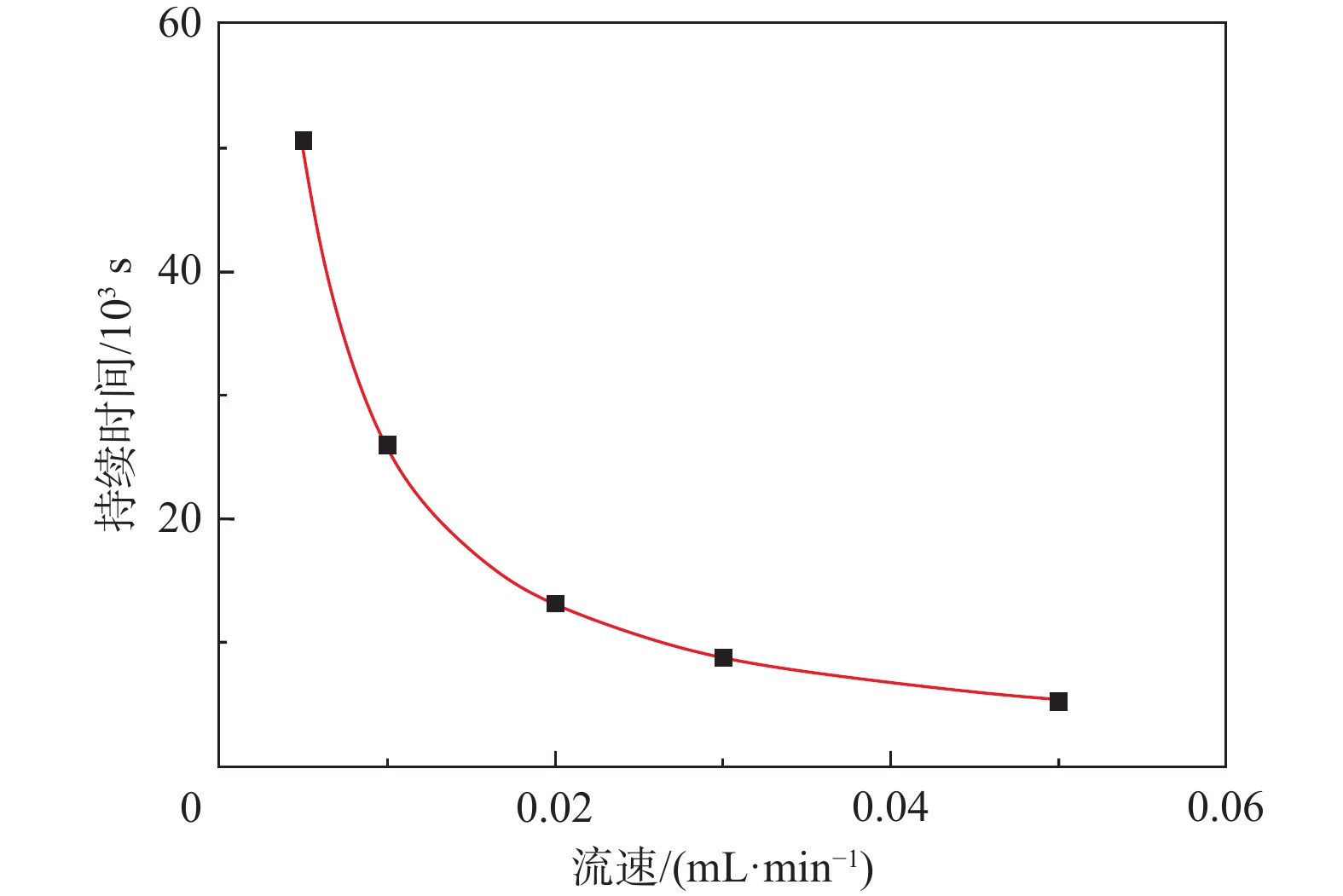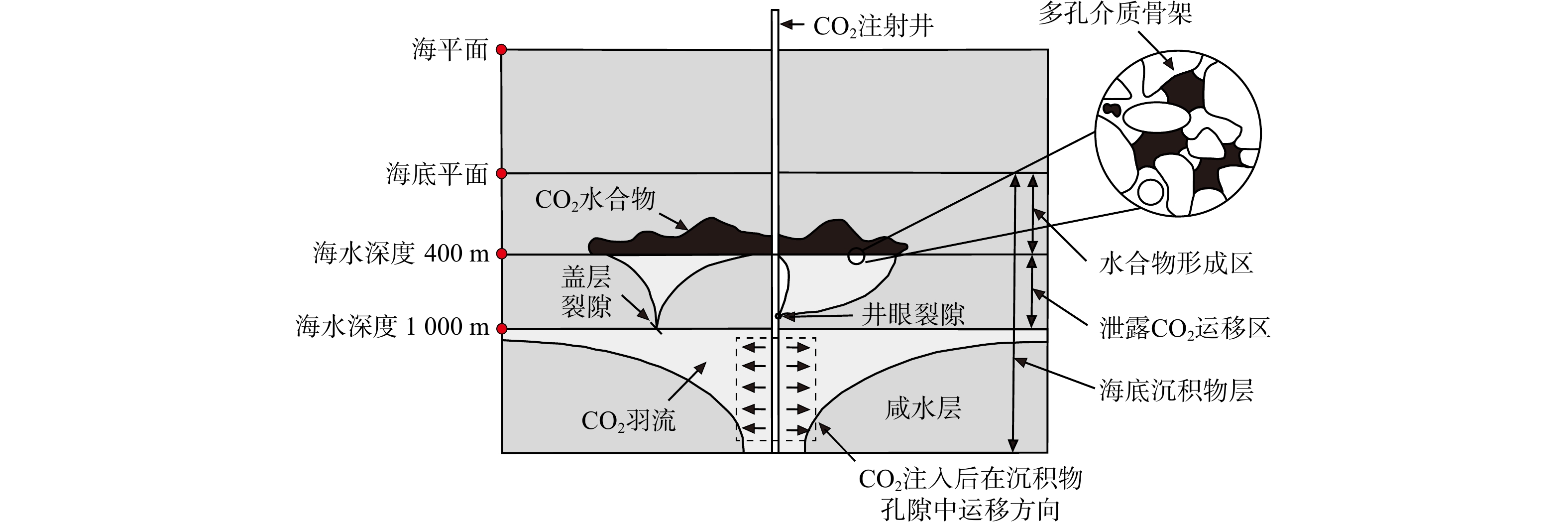Experimental on CO2 plugging effect and instability condition of hydrate in fracture of seafloor sediments
-
摘要:
海底二氧化碳(CO2)地质封存技术已成为目前碳封存、碳中和研究的热点,我国南海北部海底沉积层中存在CO2水合物形成的有利空间和温压条件,在裂隙和孔隙中形成CO2水合物,能够阻挡CO2进一步向上运移而产生自封堵能力。然而,目前裂隙中CO2水合物封堵效果与失稳条件仍不明确。采用高压低温水合物生长失稳可视化实验平台,模拟2℃、3~4 MPa的海底沉积盖层条件,观测裂隙中CO2水合物的形成与注水增压失稳过程,利用突破压力、突破压差、持续时间、失稳起始阶段渗透率及封堵率为指标对水合物失稳条件与封堵效果进行研究。研究结果表明,裂隙中水合物的形成经历成核、扩张、成型与聚集4个阶段;裂隙中形成的水合物能够高效地封堵水和CO2等流体的迁移,但在流体压力逐渐增加达到临界突破压力时开始出现失稳现象,水合物的失稳经历粒度退化与表面摩擦破坏2个阶段,水合物团块内核部先失稳,在水合物表面未破裂前可保持封堵状态;实验探究裂隙中水合物失稳条件,其突破压力为6.414~6.966 MPa,突破压差为2.403~3.203 MPa,决定水合物突破压力的关键因素是温度和压力条件,而流速的效应则主要体现在调节水合物进入失稳状态的具体时间;在3~4 MPa的海底沉积盖层条件,裂隙模型中水合物封堵率为99.0%~99.6%,失稳起始阶段渗透率为0.555×10−3~1.260×10−3 μm2。需要保证封盖CO2水合物层之下压力与海底实际压力之差小于2 MPa,以保持水合物的封堵效果。研究结果为南海类似条件下CO2海底地质封存上覆盖层风险性评价提供参考。
Abstract:Objective Seabed carbon dioxide (CO2) geological sequestration technology has become a hot spot in carbon sequestration and carbon neutralization. There are favorable space and temperature and pressure conditions for the formation of CO2 hydrate in the seabed sediments in the northern part of the South China Sea, and the formation of CO2 hydrate in the cracks and pores can block the further upward migration of CO2 and generate self-sealing capacity. However, the CO2 leakage in the fracture and the effect of hydrate plugging and instability conditions are still unclear.
Methods In this paper, the visualization experiment platform of hydrate growth and the instability process of water injection supercharging at high pressure and low temperature was used to observe the formation of CO2 hydrate and experiment platform was used to simulate the conditions of seafloor sedimentary cover under the conditions of 2℃ and 3~4 MPa, and the hydrate instability condition and plugging effect were evaluated with the breakthrough pressure, breakthrough pressure difference, duration, permeability coefficient of initial instability stage and plugging rate as indicators.
Results The experimental results show that hydrate formation can be simplified into four processes: nucleation, expansion, forming and aggregation. Hydrate formed in cracks can efficiently block the migration of fluids such as water and CO2, but the instability phenomenon begins when the fluid pressure gradually increases and reaches the critical breakthrough pressure. The instability process of hydrate can be simplified into two parts: particle size degradation and surface friction failure. The core of hydrate mass is unstable first, and the sealing state can be maintained before the surface of hydrate fails to friction fracture. The instability conditions of hydrate in the fracture are investigated experimentally. The breakthrough pressure is 6.414~6.966 MPa and the breakthrough pressure difference is 2.403~3.203 MPa. The instability rate of hydrate is mainly affected by the flow rate, followed by the saturation of hydrate, and the flow rate affects the instability rate through the interface effect. The key factors determining the breakthrough pressure of hydrate are temperature and pressure conditions, while the effect of flow rate is mainly reflected in regulating the specific time when hydrate enters the instability state. Under the condition of 3~4 MPa seafloor sedimentary cover, the sealing rate is 99.0~99.6% and the permeability coefficient of initial instability stage is 0.555~1.260 md.
Conclusion The experimental results provide a reference for the risk assessment of the overlying layer under similar conditions in the South China Sea for CO2 seabed geological sequestration. The difference between the pressure under the capped CO2 hydrate layer and the actual pressure on the seabed should be ensured to be less than 2 MPa to maintain the sealing effect of the hydrate.
-
Key words:
- carbon dioxide(CO2) /
- sub-sea sediments /
- hydrate /
- plugged effect
-
图 1 海底地层内CO2水合物封存物理模型[3]
Figure 1. Physical model of CO2 hydrate storage in seafloor
表 1 失稳条件与封堵效果评价
Table 1. Instability condition and evaluation of plugged effect
驱替速度/
(mL·min)初始饱和度/
%失稳起始阶段
渗透率/10−3 μm2封堵率/
%突破压力/
MPa突破压差/
MPa失稳时间/
s持续时间/
s0.005 85.3 0.771 99.4 6.703 2.403 6311 50633 0.010 80.1 0.555 99.6 6.966 3.131 6054 25999 0.020 70.3 0.828 99.3 6.414 3.203 1983 13149 0.030 75.2 0.938 99.2 6.593 3.004 1659 8759 0.050 78.9 1.260 99.0 6.497 2.572 1082 5165 -
[1] AMINU M D,ALI NABAVI S,ROCHELLE C A,et al. A review of developments in carbon dioxide storage[J]. Applied Energy,2017,208:1389-1419. doi: 10.1016/j.apenergy.2017.09.015 [2] 雷晓,邓建强,张早校. 海底沉积物层CO2封存中水合物研究进展[J]. 化工进展,2012,31(6):1338-1346.LEI X,DENG J Q,ZHANG Z X. Research advancement in hydrate formation during CO2 sub-sea sediments sequestration[J]. Chemical Industry and Engineering Progress,2012,31(6):1338-1346. (in Chinese with English abstract [3] 李洛丹,刘妮,刘道平. 二氧化碳海洋封存的研究进展[J]. 能源与环境,2008(6):11-12. doi: 10.3969/j.issn.1672-9064.2008.06.005LI L D,LIU N,LIU D P. Research progress of marine storage of carbon dioxide[J]. Energy and Environment,2008(6):11-12. (in Chinese with English abstract doi: 10.3969/j.issn.1672-9064.2008.06.005 [4] 孙玉景,周立发,李越. CO2海洋封存的发展现状[J]. 地质科技情报,2018,37(4):212-218.SUN Y J,ZHOU L F,LI Y. Development status of CO2 marine sequestration[J]. Geological Science and Technology Information,2018,37(4):212-218. (in Chinese with English abstract [5] 祁生文,郑博文,王赞,等. 二氧化碳地质利用与封存场址的地质评价[J]. 中国科学:地球科学,2023,53(9):1937-1957. doi: 10.1360/N072022-0351QI S W,ZHENG B W,WANG Z,et al. Geological evaluation for the carbon dioxide geological utilization and storage(CGUS)site[J]. Scientia Sinica (Terrae),2023,53(9):1937-1957. (in Chinese with English abstract doi: 10.1360/N072022-0351 [6] HOLLOWAY S. Storage capacity and containment issues for carbon dioxide capture and geological storage on the UK continental shelf[J]. Proceedings of the Institution of Mechanical Engineers,Part A:Journal of Power and Energy,2009,223(3):239-248. doi: 10.1243/09576509JPE650 [7] TOHIDI B,YANG J H,SALEHABADI M,et al. CO2 hydrates could provide secondary safety factor in subsurface sequestration of CO2[J]. Environmental Science & Technology,2010,44(4):1509-1514. [8] GAUTEPLASS J,ALMENNINGEN S,ERSLAND G,et al. Multiscale investigation of CO2 hydrate self-sealing potential for carbon geo-sequestration[J]. Chemical Engineering Journal,2020,381:122646. doi: 10.1016/j.cej.2019.122646 [9] ZHAO G J,ZHENG J N,GONG G J,et al. Formation characteristics and leakage termination effects of CO2 hydrate cap in case of geological sequestration leakage[J]. Applied Energy,2023,351:121896. doi: 10.1016/j.apenergy.2023.121896 [10] ZHAO G J,YANG M J,PANG W X,et al. Effects of hydrate cap on leakage prevention and capacity improvement of sub-seabed CO2 sequestration[J]. Chemical Engineering Journal,2022,450:138493. doi: 10.1016/j.cej.2022.138493 [11] TENG H O,YAMASAKI A. Pressure-mole fraction phase diagrams for CO2-pure water system under temperatures and pressures corresponding to ocean waters at depth to 3000 m[J]. Chemical Engineering Communications,2002,189(11):1485-1497. doi: 10.1080/00986440214993[12] ALMENNINGEN S,GAUTEPLASS J,FOTLAND P,et al. Visualization of hydrate formation during CO2 storage in water-saturated sandstone[J]. International Journal of Greenhouse Gas Control,2018,79:272-278. doi: 10.1016/j.ijggc.2018.11.008 [13] LIM V W S,BARWOOD M T J,METAXAS P J,et al. Nucleation rates of carbon dioxide hydrate[J]. Chemical Engineering Journal,2022,443:136359. doi: 10.1016/j.cej.2022.136359 [14] 曹学文,杨凯然,杨健,等. 高压CO2水合物的生成机理实验和模拟[J]. 高压物理学报,2021,35(3):173-180.CAO X W,YANG K R,YANG J,et al. Experiment and simulation of carbon dioxide hydrate formation mechanism under high pressure[J]. Chinese Journal of High Pressure Physics,2021,35(3):173-180. (in Chinese with English abstract [15] 张立贺,包瑞新,宋书宇,等. 倾斜管中CO2水合物生成及堵管实验研究[J]. 天然气化工—C1化学与化工,2022,47(1):80-86.ZHANG L H,BAO R X,SONG S Y,et al. Experimental research on CO2 hydrate formation and pipe blocking in inclined pipe[J]. Natural Gas Chemical Industry,2022,47(1):80-86. (in Chinese with English abstract [16] BAI Y J,CAO G S,AN H X,et al. Generation laws and distribution characteristics of carbon dioxide hydrate in a reaction kettle[J]. Experimental Thermal and Fluid Science,2020,116:110125. doi: 10.1016/j.expthermflusci.2020.110125 [17] MICHAEL K,GOLAB A,SHULAKOVA V,et al. Geological storage of CO2 in saline aquifers:A review of the experience from existing storage operations[J]. International Journal of Greenhouse Gas Control,2010,4(4):659-667. doi: 10.1016/j.ijggc.2009.12.011 [18] HAUGE L P,GAUTEPLASS J,HØYLAND M D,et al. Pore-level hydrate formation mechanisms using realistic rock structures in high-pressure silicon micromodels[J]. International Journal of Greenhouse Gas Control,2016,53:178-186. doi: 10.1016/j.ijggc.2016.06.017 [19] MAEDA N. Nucleation curve of carbon dioxide hydrate[J]. Energy Procedia,2019,158:5928-5933. doi: 10.1016/j.egypro.2019.01.530 [20] TANG M R,WANG C W,DENG X A,et al. Experimental investigation on plugging performance of nanospheres in low-permeability reservoir with bottom water[J]. Advances in Geo-Energy Research,2022,6(2):95-103. doi: 10.46690/ager.2022.02.02 [21] NIU L W,LU X G,XIONG C M,et al. Experimental study on gelling property and plugging effect of inorganic gel system (OMGL)[J]. Petroleum Exploration and Development,2013,40(6):780-784. doi: 10.1016/S1876-3804(13)60104-4 [22] XU C Y,YAN X P,KANG Y L,et al. Structural failure mechanism and strengthening method of fracture plugging zone for lost circulation control in deep naturally fractured reservoirs[J]. Petroleum Exploration and Development,2020,47(2):430-440. doi: 10.1016/S1876-3804(20)60060-X [23] LEI S F,SUN J S,BAI Y R,et al. Formation mechanisms of fracture plugging zone and optimization of plugging particles[J]. Petroleum Exploration and Development,2022,49(3):684-693. doi: 10.1016/S1876-3804(22)60057-0 [24] ZHANG C,YU Q C. The effect of water saturation on methane breakthrough pressure:An experimental study on the Carboniferous shales from the eastern Qaidam Basin,China[J]. Journal of Hydrology,2016,543:832-848. doi: 10.1016/j.jhydrol.2016.11.003 [25] 罗亚南,蒋坤卿,黄思浩,等. 地热水回灌耦合CO2地质封存系统安全性分析[J]. 地质科技通报,2024,43(3):59-67.LUO Y N,JIANG K Q,HUANG S H,et al. Safety analysis of geothermal water recharge coupled with CO2 geological storage system[J]. Bulletin of Geological Science and Technology,2024,43(3):59-67. (in Chinese with English abstract [26] 郁桂刚,欧文佳,吴翔,等. 天然气水合物分解动力学研究进展[J]. 地质科技通报,2023,42(3):175-188.YU G G,OU W J,WU X,et al. Research advances on the dissociation dynamics of natural gas hydrates[J]. Bulletin of Geological Science and Technology,2023,42(3):175-188. (in Chinese with English abstract [27] MURAOKA M,YAMAMOTO Y,TENMA N. Simultaneous measurement of water permeability and methane hydrate pore habit using a two-dimensional glass micromodel[J]. Journal of Natural Gas Science and Engineering,2020,77:103279. doi: 10.1016/j.jngse.2020.103279 [28] ZHANG Z,LI Z K,LI C F,et al. Analysis of permeability anisotropy of marine hydrate-bearing sediments using fractal theory combined with X-CT[J]. Ocean Engineering,2024,301:117492. doi: 10.1016/j.oceaneng.2024.117492 [29] LI Y,LV L,MING L,et al. Quantitative investigation of phase characteristic effects on CO2 breakthrough pressures in unsaturated low-permeability sandstone[J]. Journal of Hydrology,2022,609:127780. doi: 10.1016/j.jhydrol.2022.127780 [30] DAI S,SEOL Y. Water permeability in hydrate-bearing sediments:A pore-scale study[J]. Geophysical Research Letters,2014,41(12):4176-4184. doi: 10.1002/2014GL060535 [31] DENG W,LIANG J Q,KUANG Z G,et al. Estimation of gas hydrate saturation regarding the hydrate morphology in hydrate-bearing sands in the Qiongdongnan Basin,South China Sea[J]. Pure and Applied Geophysics,2023,180(7):2757-2773. doi: 10.1007/s00024-023-03299-7 [32] FERDOWS M,OTA M. Density of CO2 hydrate by Monte Carlo simulation[J]. Proceedings of the Institution of Mechanical Engineers,Part C:Journal of Mechanical Engineering Science,2006,220(5):691-696. doi: 10.1243/09544062C13104 [33] LI C H,ZHAO Q,XU H J,et al. Relation between relative permeability and hydrate saturation in Shenhu area,South China Sea[J]. Applied Geophysics,2014,11(2):207-214. doi: 10.1007/s11770-014-0432-6 [34] ZHOU J L,WANG X J,COLLETT T S,et al. Characterization of a complex sand-rich gas hydrate reservoir system in the Indian marine continental margin with downhole log and seismic data[J]. Marine and Petroleum Geology,2023,155:106370. doi: 10.1016/j.marpetgeo.2023.106370 [35] ZHOU X Q,WU S G,BOSIN A,et al. Evaluation of CO2 hydrate storage potential in the Qiongdongnan Basin via combining the phase equilibrium mechanism and the volumetric method[J]. Advances in Geo-Energy Research,2024,11(3):220-229. doi: 10.46690/ager.2024.03.06 [36] REN X W,GUO Z Y,NING F L,et al. Permeability of hydrate-bearing sediments[J]. Earth-Science Reviews,2020,202:103100. doi: 10.1016/j.earscirev.2020.103100 [37] DELLI M L,GROZIC J L H. Experimental determination of permeability of porous media in the presence of gas hydrates[J]. Journal of Petroleum Science and Engineering,2014,120:1-9. doi: 10.1016/j.petrol.2014.05.011 [38] REZAEI A,HASSANPOURYOUZBAND A,MOLNAR I,et al. Relative permeability of hydrogen and aqueous brines in sandstones and carbonates at reservoir conditions[J]. Geophysical Research Letters,2022,49(12):e99433. [39] 阮博阳,杨盼瑞,郭会荣,等. 基于PIV技术研究不连通孔隙中残余DNAPL的溶解速率影响因素[J]. 地质科技通报,2023,42(4):241-249.RUAN B Y,YANG P R,GUO H R,et al. Factors influencing the dissolution rate of residual DNAPL in unconnected pores based on PIV technology[J]. Bulletin of Geological Science and Technology,2023,42(4):241-249. (in Chinese with English abstract [40] 周媛,杨盼瑞,郭会荣,等. 注入丁醇调节重非水液相密度的微空隙试验模拟[J]. 地质科技通报,2022,41(1):223-230.ZHOU Y,YANG P R,GUO H R,et al. Microvoid experiment simulation of density adjustment of heavy non-aqueous liquid phase by butanol injection[J]. Bulletin of Geological Science and Technology,2022,41(1):223-230. (in Chinese with English abstract [41] HE C R,WANG T K,ZHAO Z X,et al. One-dimensional analytical solution for hydraulic head and numerical solution for solute transport through a horizontal fracture for submarine groundwater discharge[J]. Journal of Contaminant Hydrology,2017,206:1-9. doi: 10.1016/j.jconhyd.2017.08.012 -




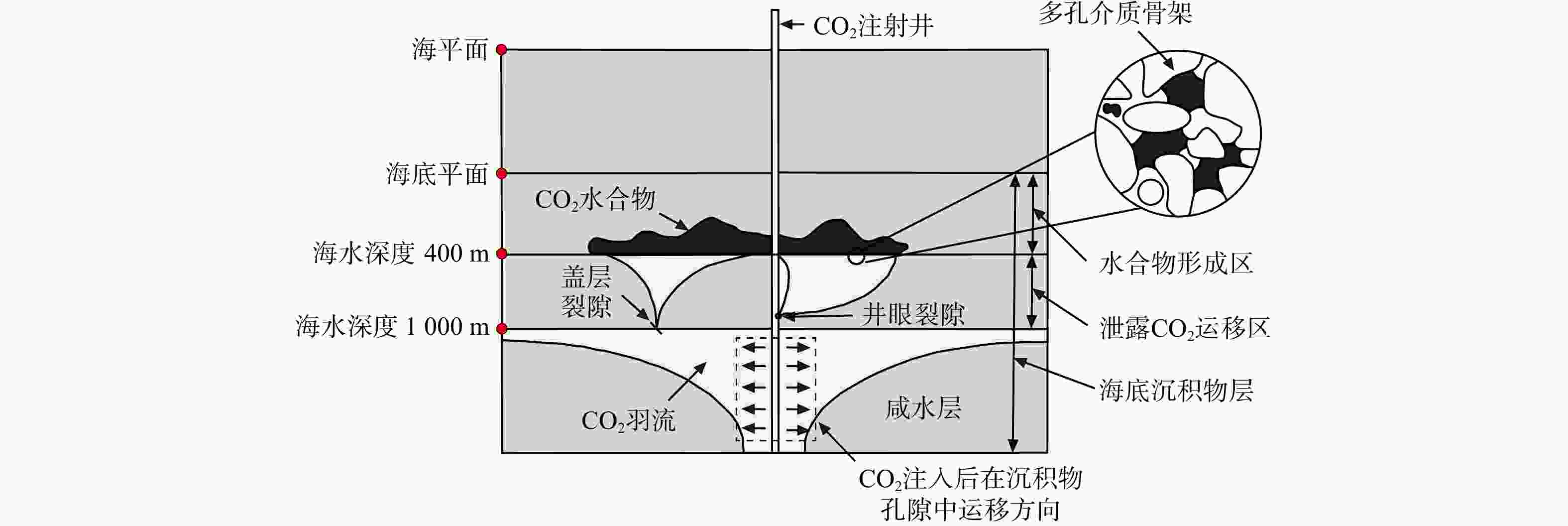
 下载:
下载:
